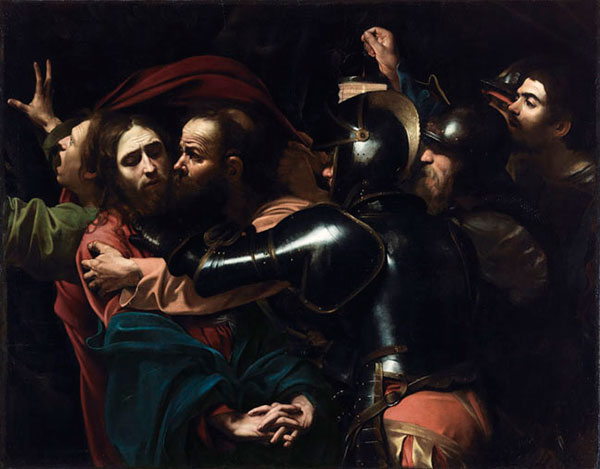
In this occasional series, Fine Art Today delves into the world of portraiture, highlighting historical and contemporary examples of superb quality and skill. This week: Michelangelo Caravaggio, “The Betrayal.”
We know what you’re thinking. How can Michelangelo Caravaggio’s 1602 narrative masterpiece “The Betrayal” be featured as this week’s portraiture highlight? Indeed, Caravaggio produced little portraiture and even fewer self-portraits throughout his vexing career and life. The 1602 canvas — which today is housed in the National Gallery of Ireland, Dublin — comes into play with the artist’s seemingly remarkable and complex use of embedded self-portraiture.
In contrast to autonomous self-portraiture (i.e., the artist presenting himself or herself as a singular subject), embedded self-portraits are only part of a much larger context, which in many cases is a narrative whose primary subject is the story. “The Betrayal” has been a source of great allure and mystery for scholars in light of a possible embedded self-portrait in addition to Caravaggio’s surprising non-violent approach to — and involvement in — the subject.
“The Betrayal” is one of the artist’s most dramatic and compelling scenes, with figures painted in three-quarter length, forced so close to the picture plane that his viewers must have felt their presence. Seven men are included in the painting. To the left, a beardless youth in red and green flees the scene with arms raised as his robe flows in an arch over the heads of Christ and Judas. Christ somberly leans toward the left and gazes down, hands extended in front, still clasped in prayer. Continuing toward the right, Judas and an armored soldier grasp Christ’s right shoulder, their arms forming a complementing arch to the fleeing youth’s robe, framing the heads of Christ and Judas. Two other soldiers and a figure complete the right half of the painting.
 Along the right edge of the canvas, the bearded figure peering into the scene has been identified as Caravaggio himself. This figure bears a lantern, providing an artificial point of illumination. Caravaggio appears — to some — to occupy a position of moral neutrality in this scene. Looking on with an expression of curiosity, if not wonderment, Caravaggio appears to place himself as a bystander rather than a soldier tasked with arresting Christ.
Along the right edge of the canvas, the bearded figure peering into the scene has been identified as Caravaggio himself. This figure bears a lantern, providing an artificial point of illumination. Caravaggio appears — to some — to occupy a position of moral neutrality in this scene. Looking on with an expression of curiosity, if not wonderment, Caravaggio appears to place himself as a bystander rather than a soldier tasked with arresting Christ.
Scholars have also noted the visual “pairing” between the figure identified as Caravaggio and the fleeing youth (commonly identified as Saint John the Evangelist) along the left edge of the canvas. Consider: The two figures frame the scene, with one exiting as the other enters; one sees the principal action as the other turns away and does not see; one seeks to get away while the other seeks to get close and illuminate Christ. Considering the pose and treatment, both raise their right arms and have brightly illuminated faces.
Renowned scholar Michael Fried suggested, “It is as though the ‘Betrayal’ at once represents a particular instant in the biblical narrative and evokes a multiplicity of relationships that redirect our attention away from the events in the Garden of Gethsemane toward a very different ‘narrative,’ not declarable in any straightforward way, of the painting’s production.”
If granted, it does appear as though Caravaggio’s embedded self-portrait within “The Betrayal” has a range of interpretive possibility, including theories surrounding the artist’s own spirituality and philosophy of art.
We’d love to hear your thoughts!
Learn more about this magnificent Baroque masterpiece by visiting the National Gallery of Ireland.
This article was featured in Fine Art Today, a weekly e-newsletter from Fine Art Connoisseur magazine. To start receiving Fine Art Today for free, click here.







